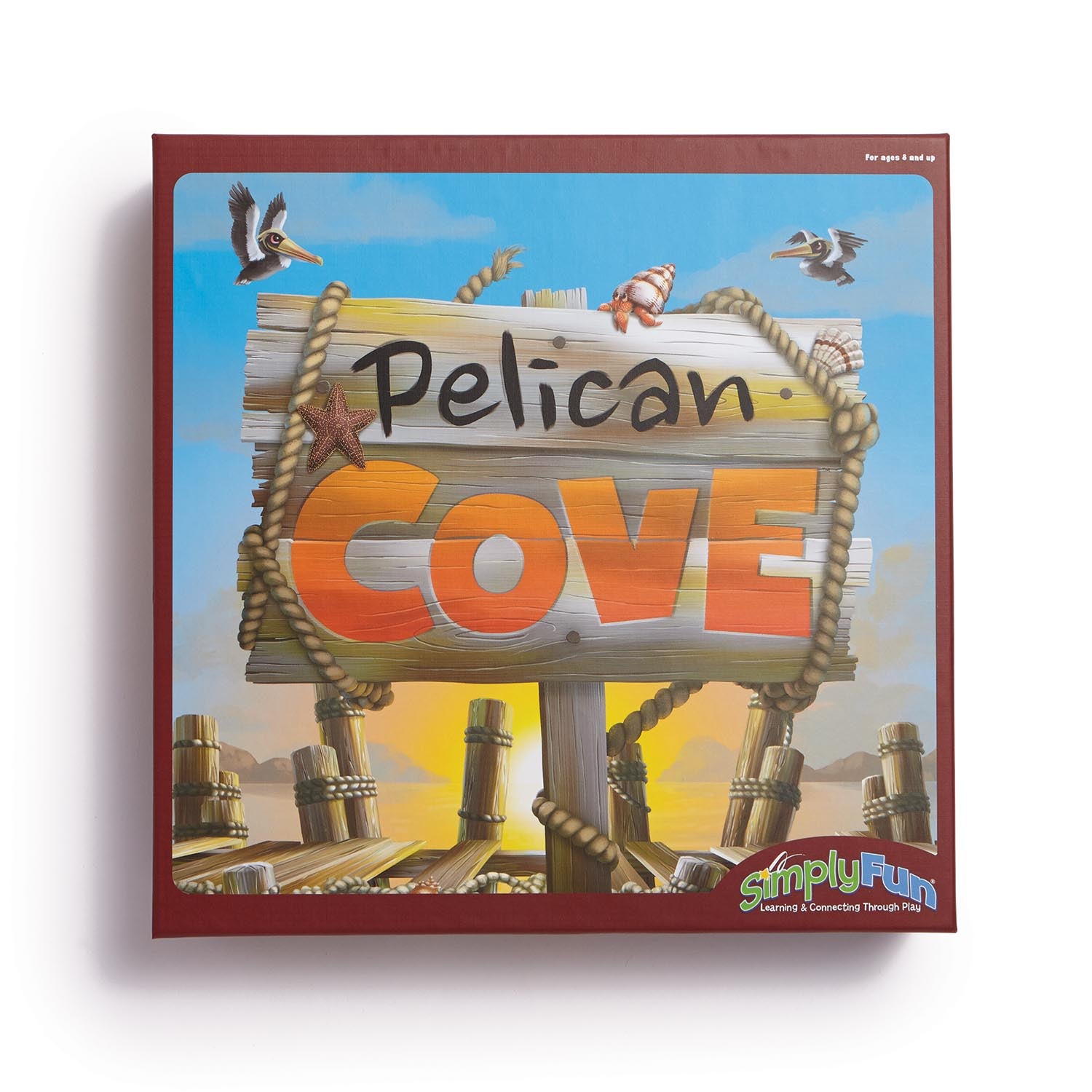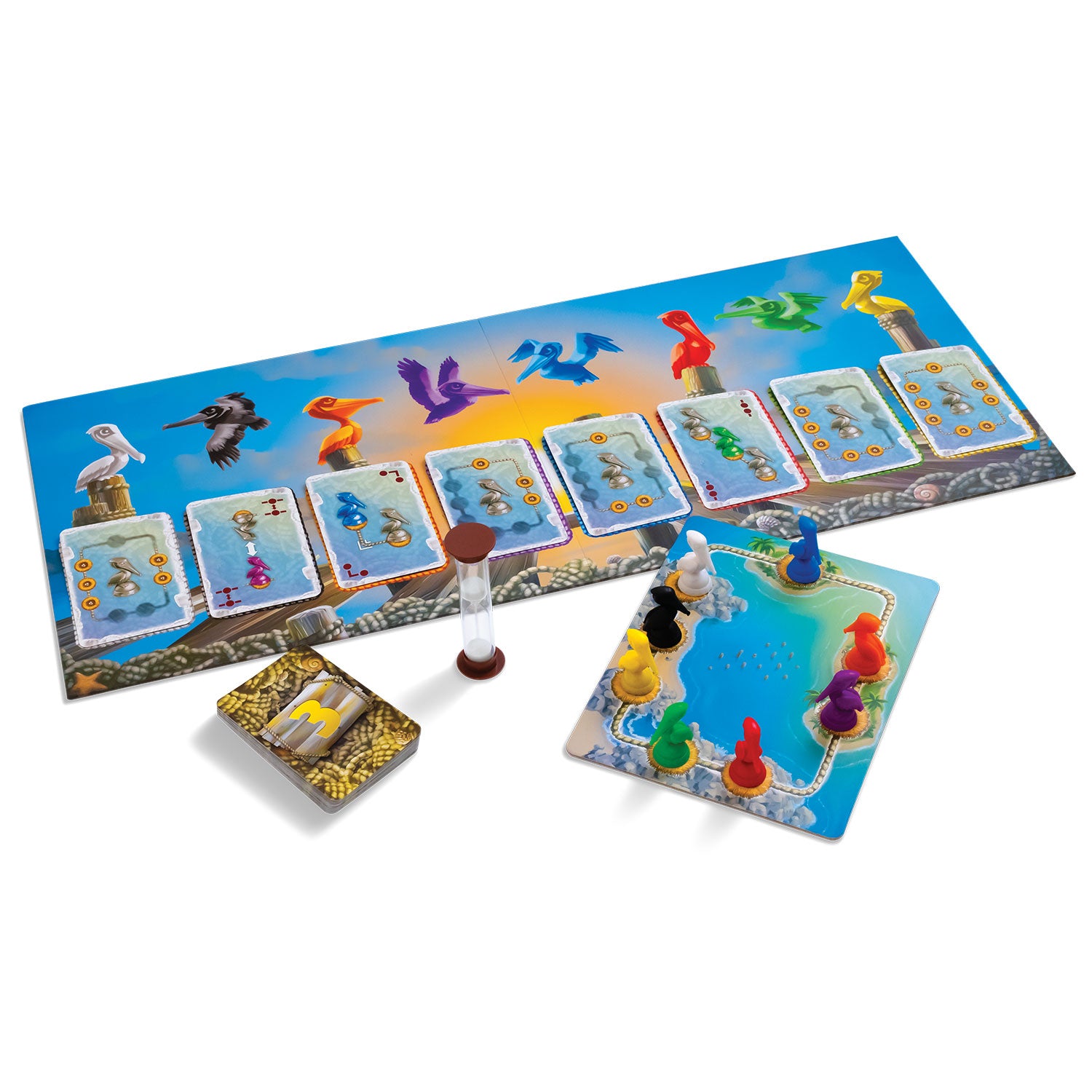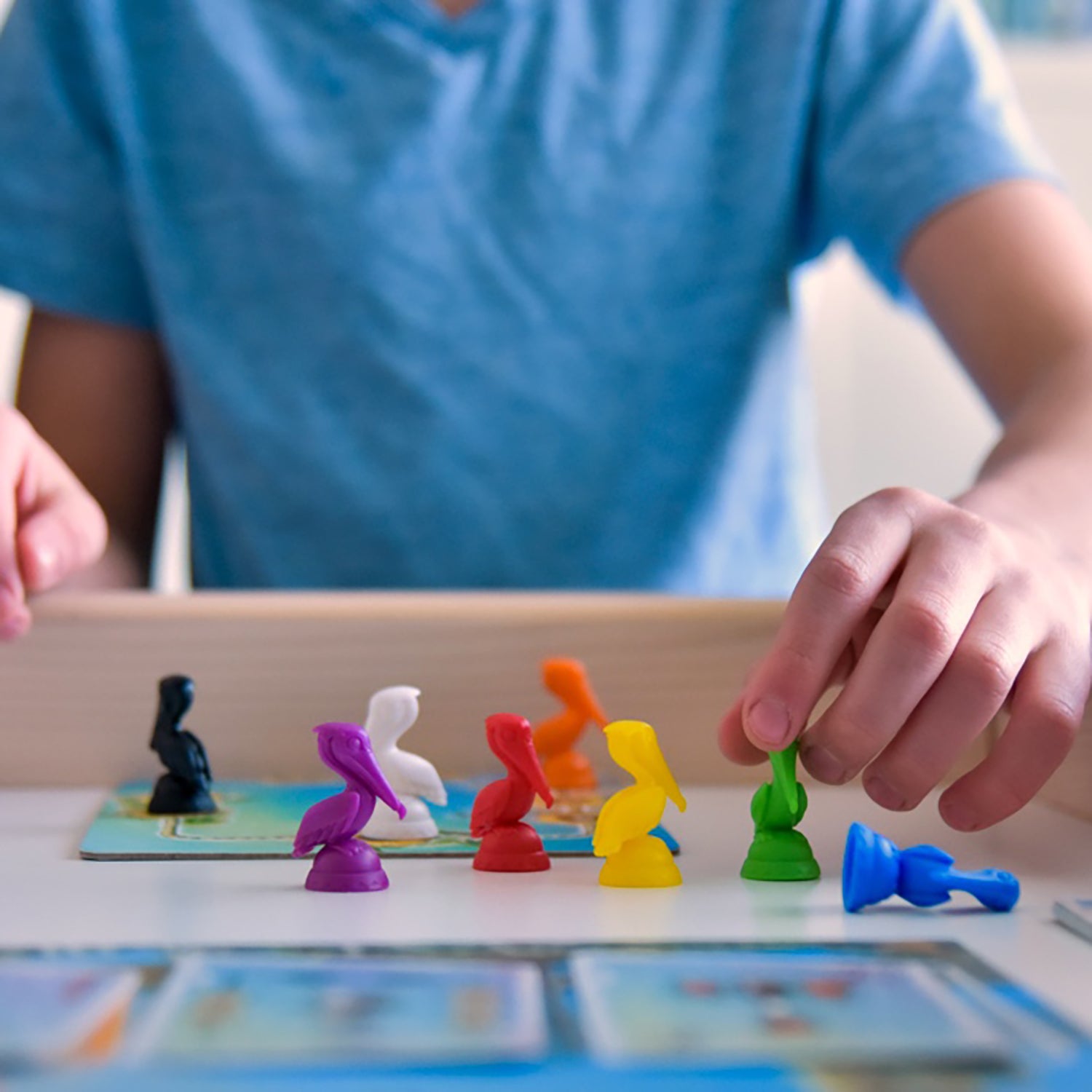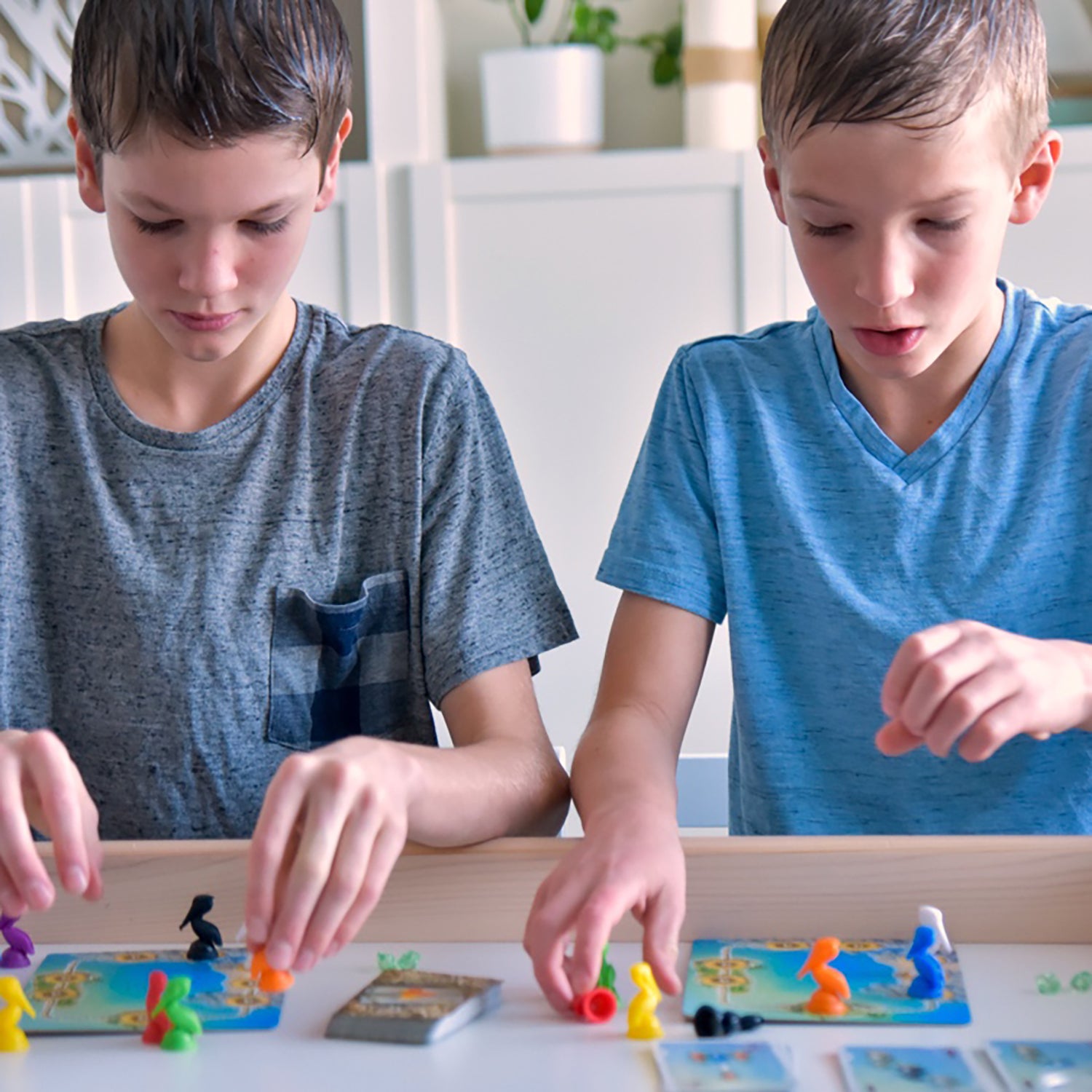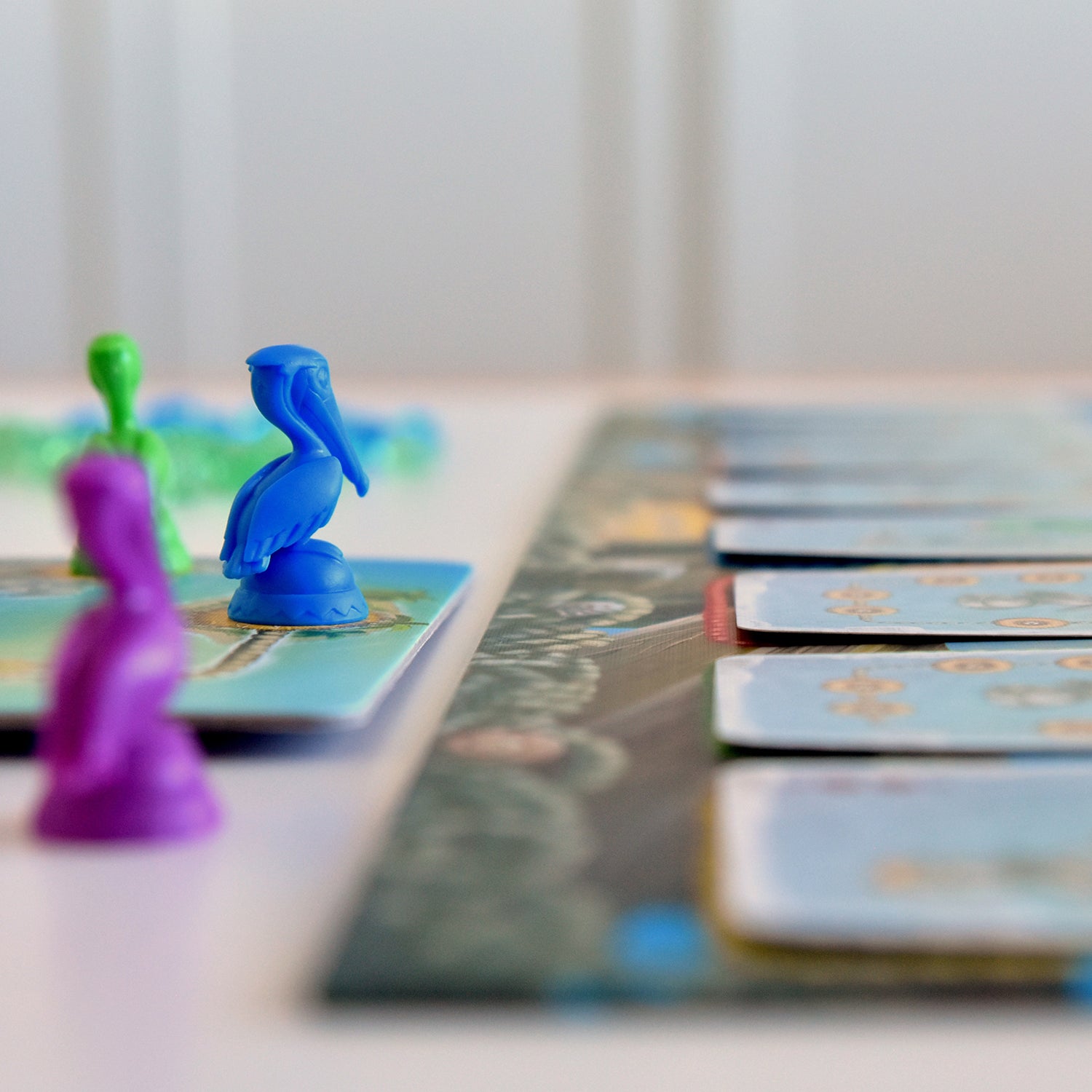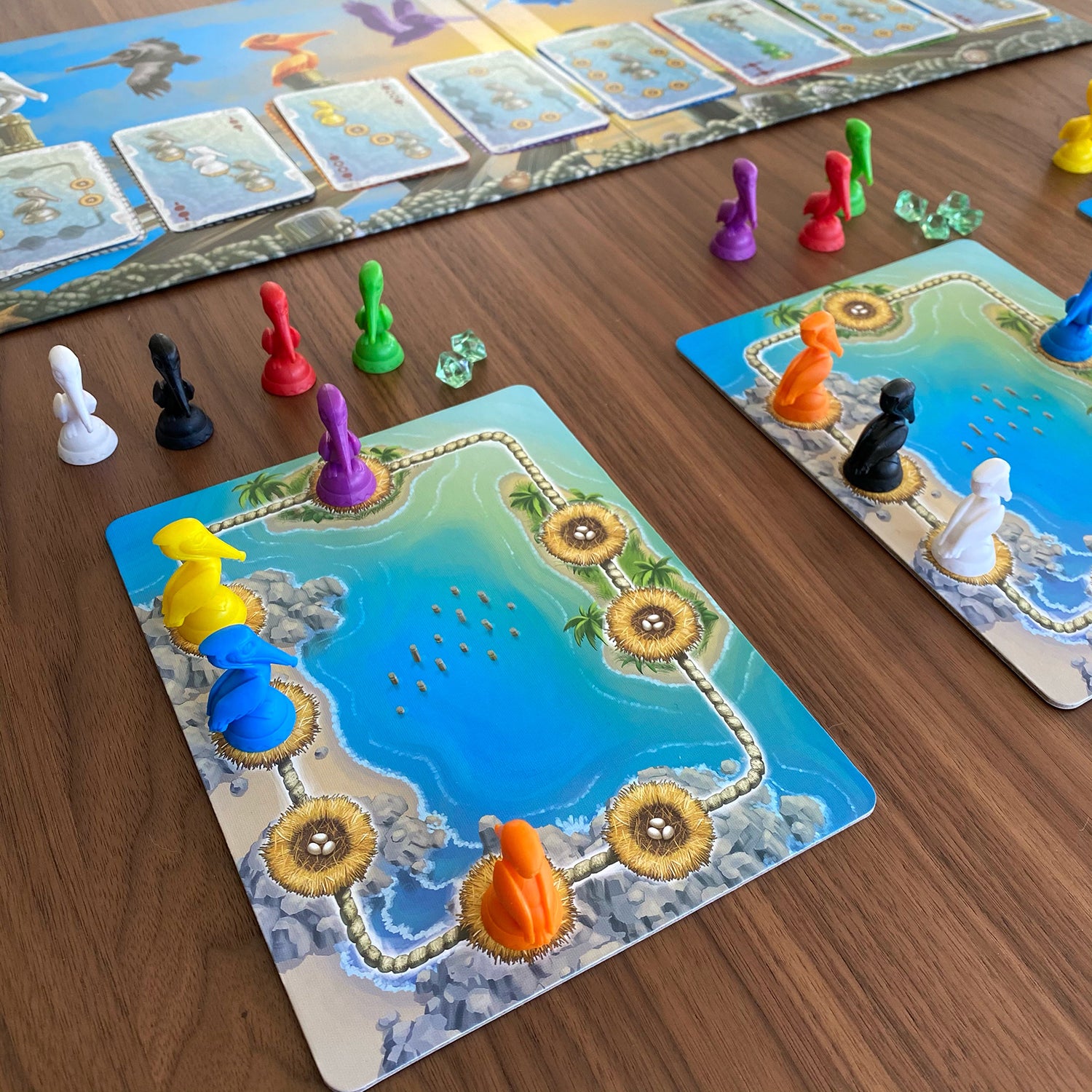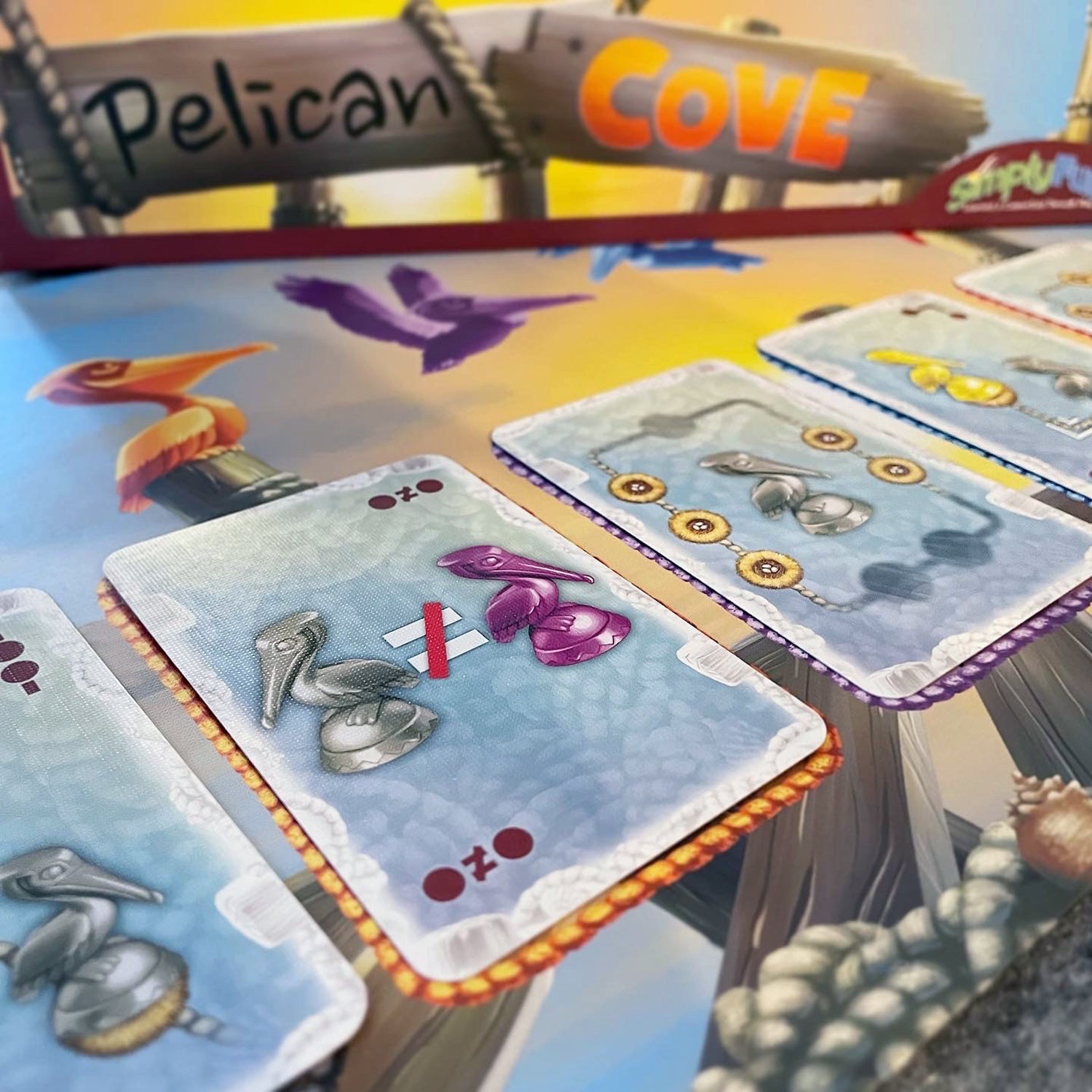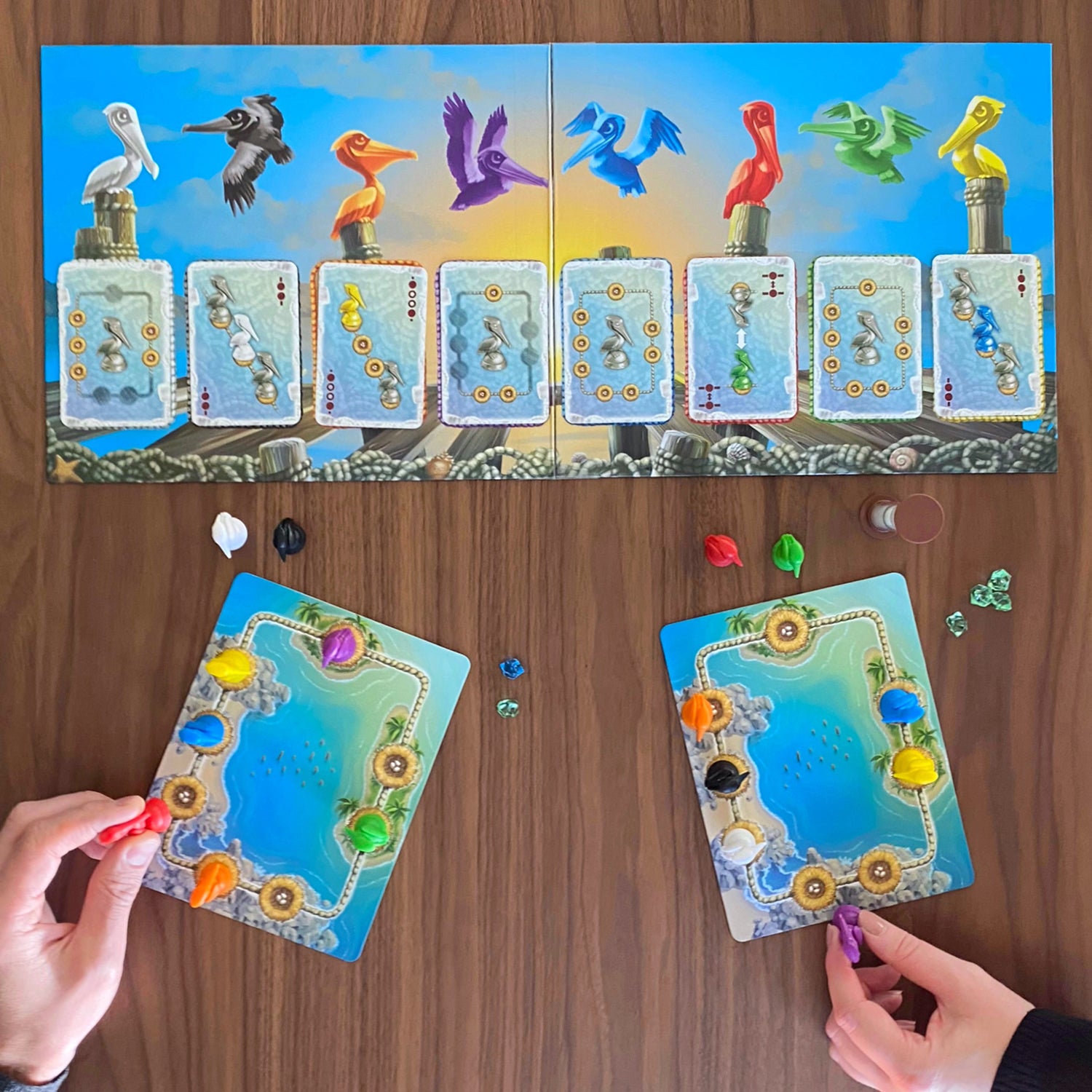Pelican Cove
Pelican Cove
1-5 players • 30 min • 8 & up
Focus: Algebra
Couldn't load pickup availability
Think fast to get your pelicans nested before time runs out in this fast-paced game. Each pelican has their own preferences. Can you make them all happy? Only time will tell!
Skills: Algebra, Spatial Reasoning, Quick Thinking
Game Includes
Game Includes
- 1 Two-Sided Game Board
- 5 Nesting Boards
- 40 Pelican Pawns in 8 Colors
- 80 Request Cards
- 40 Penalty Stones
- 1 45-Second Sand Timer
- 1 Rules Booklet
Share
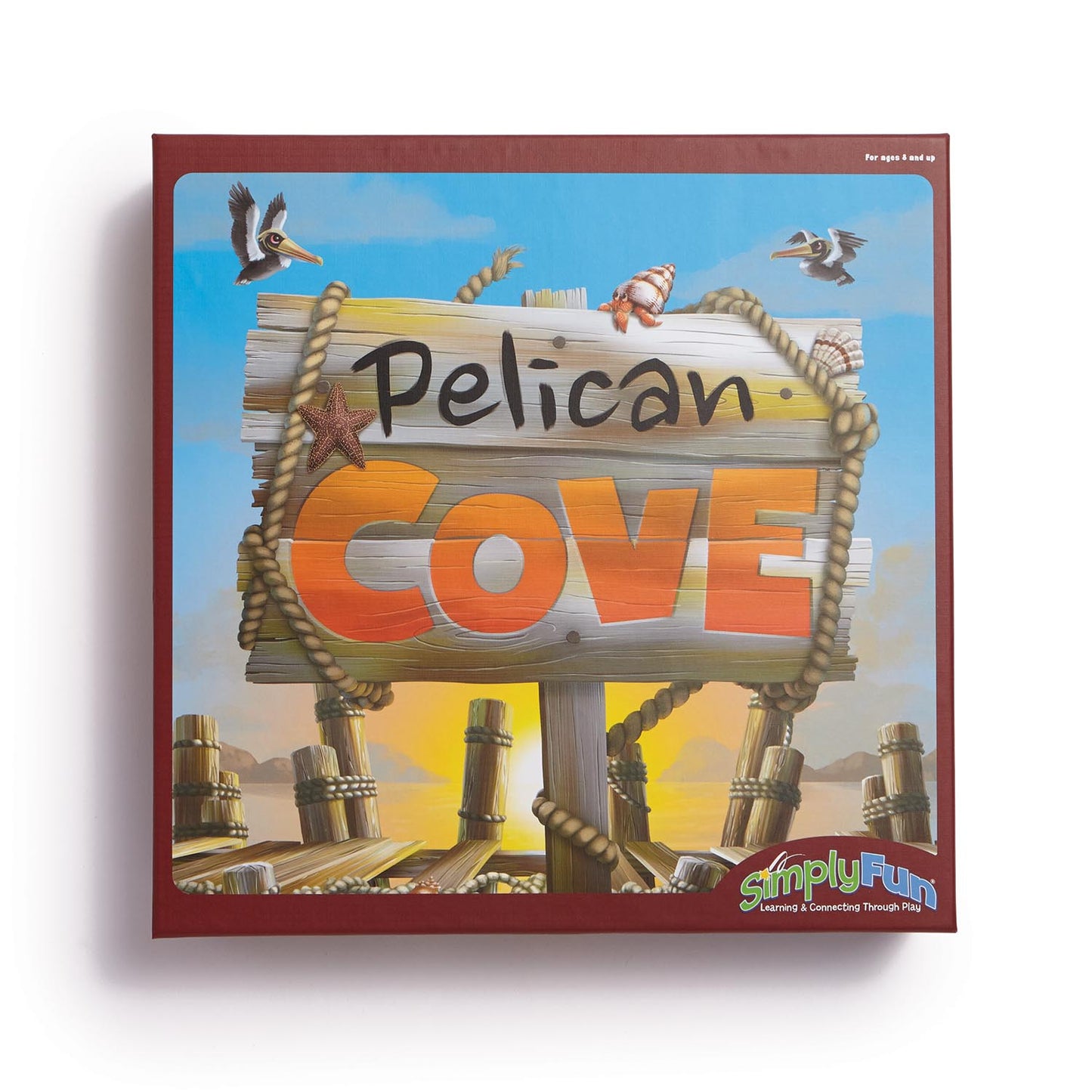
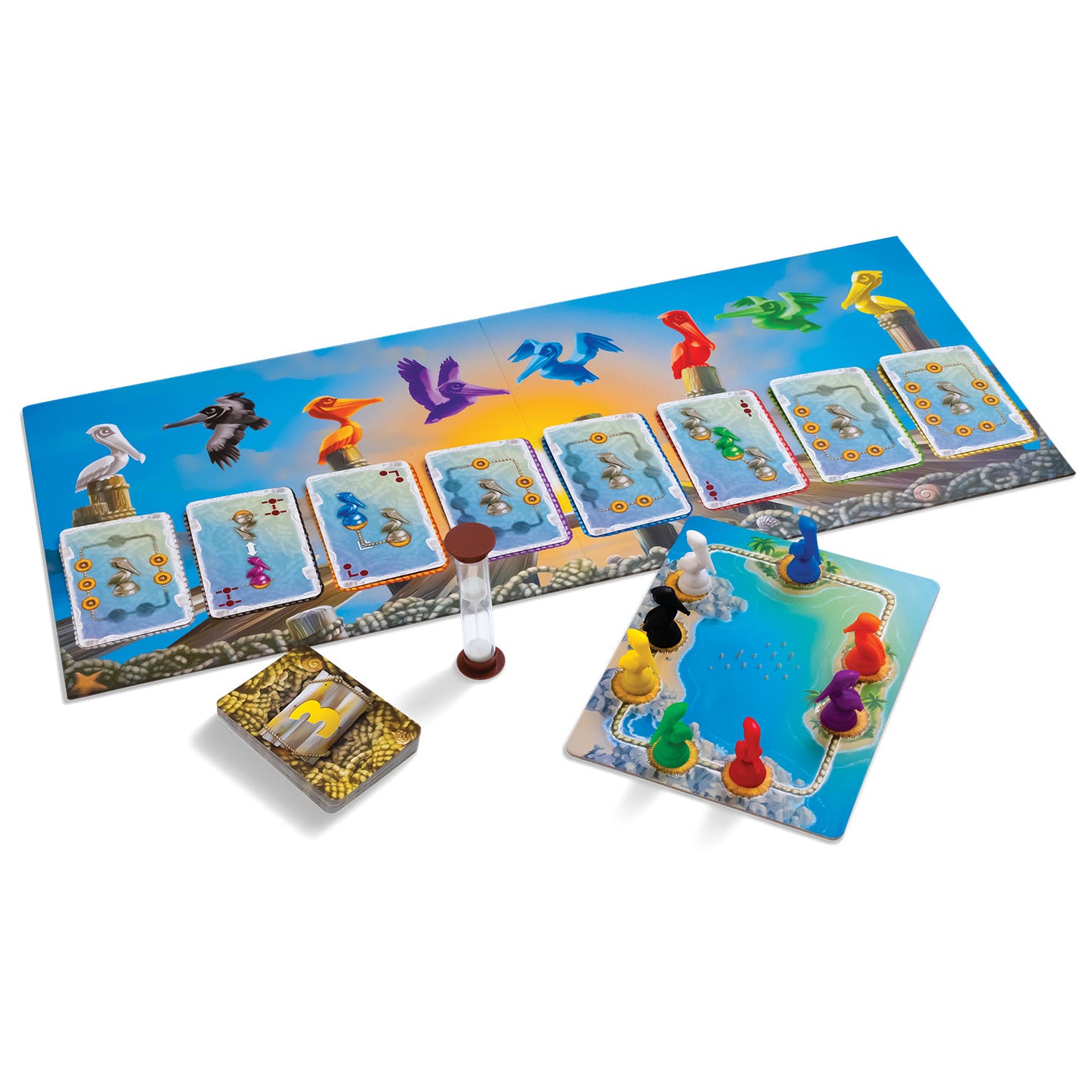
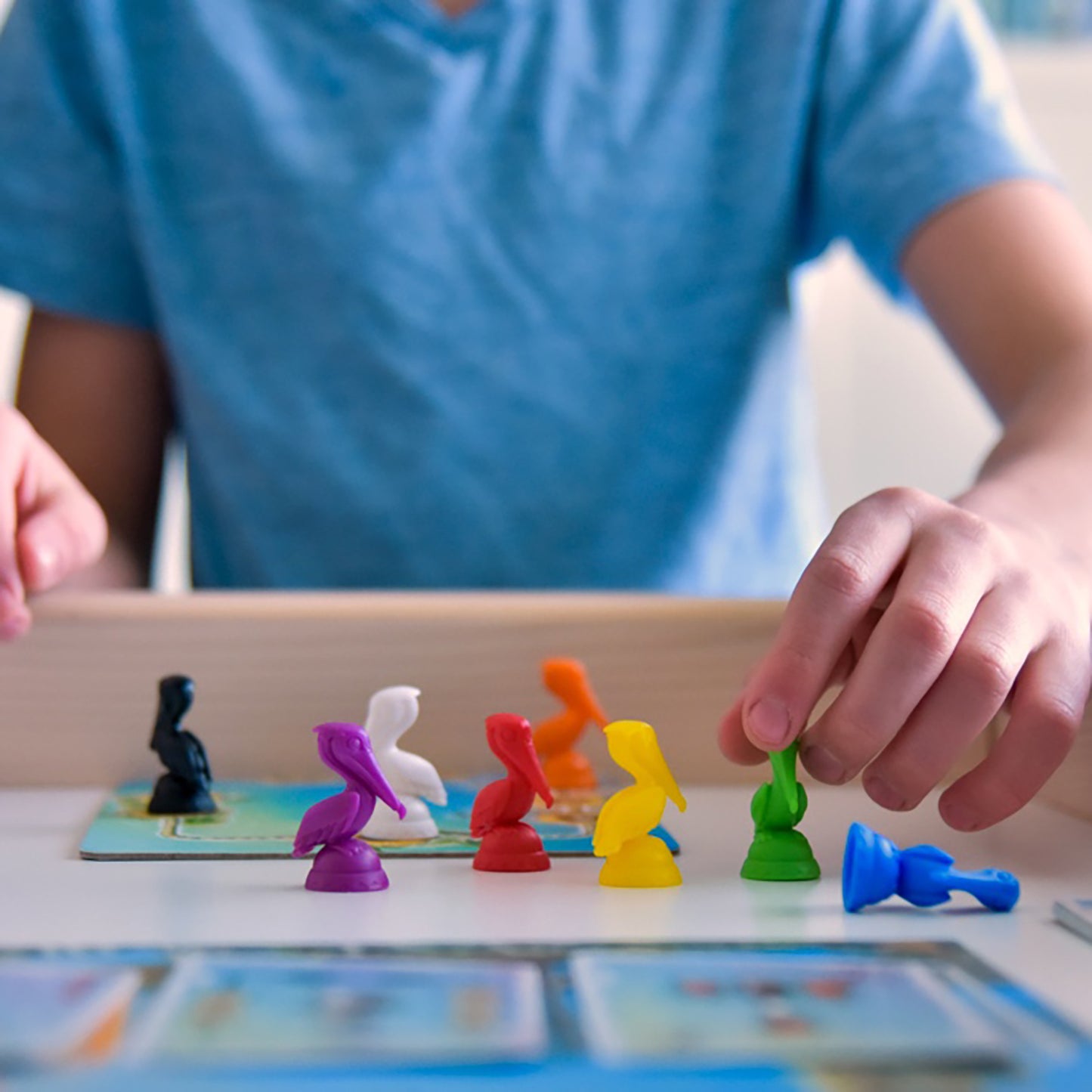
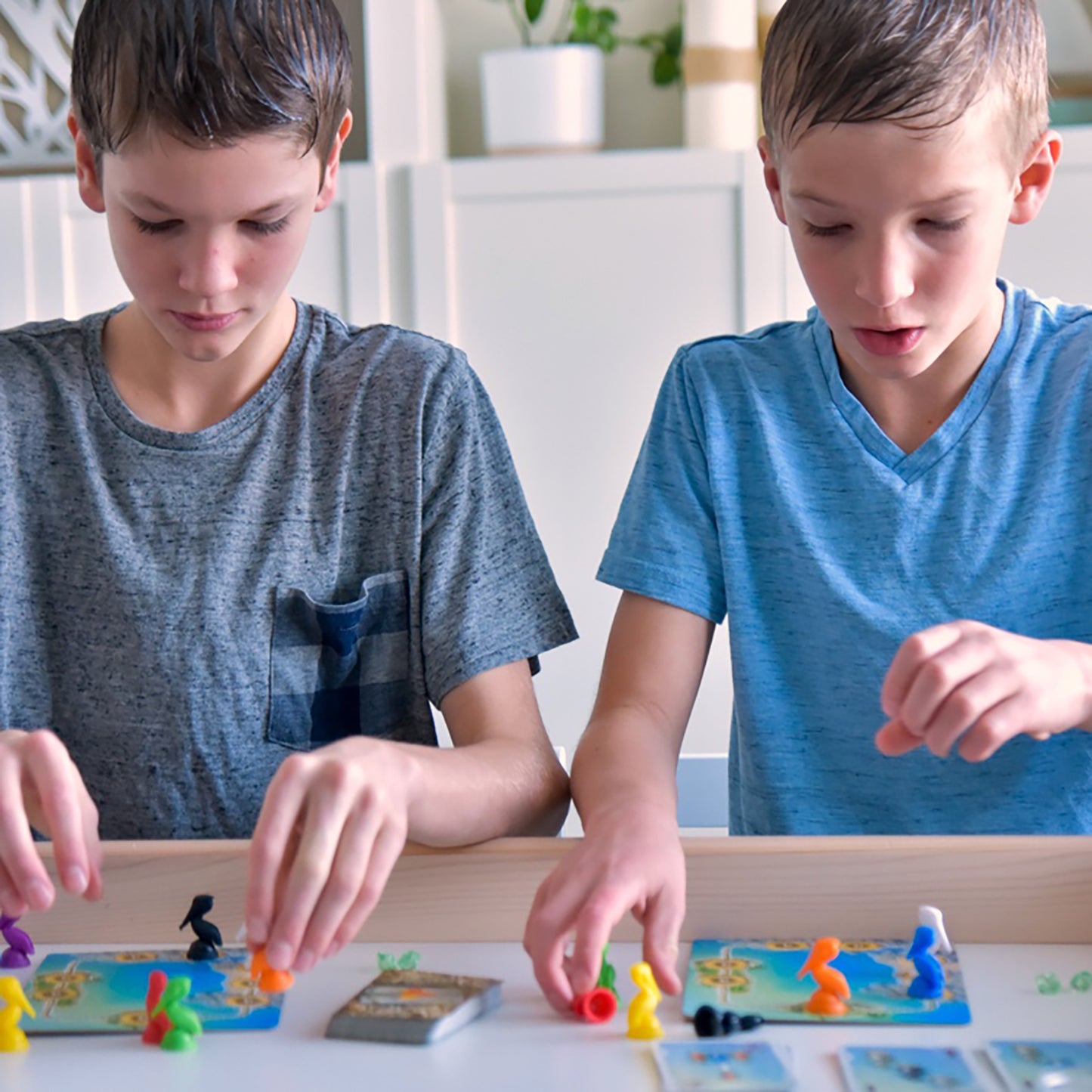
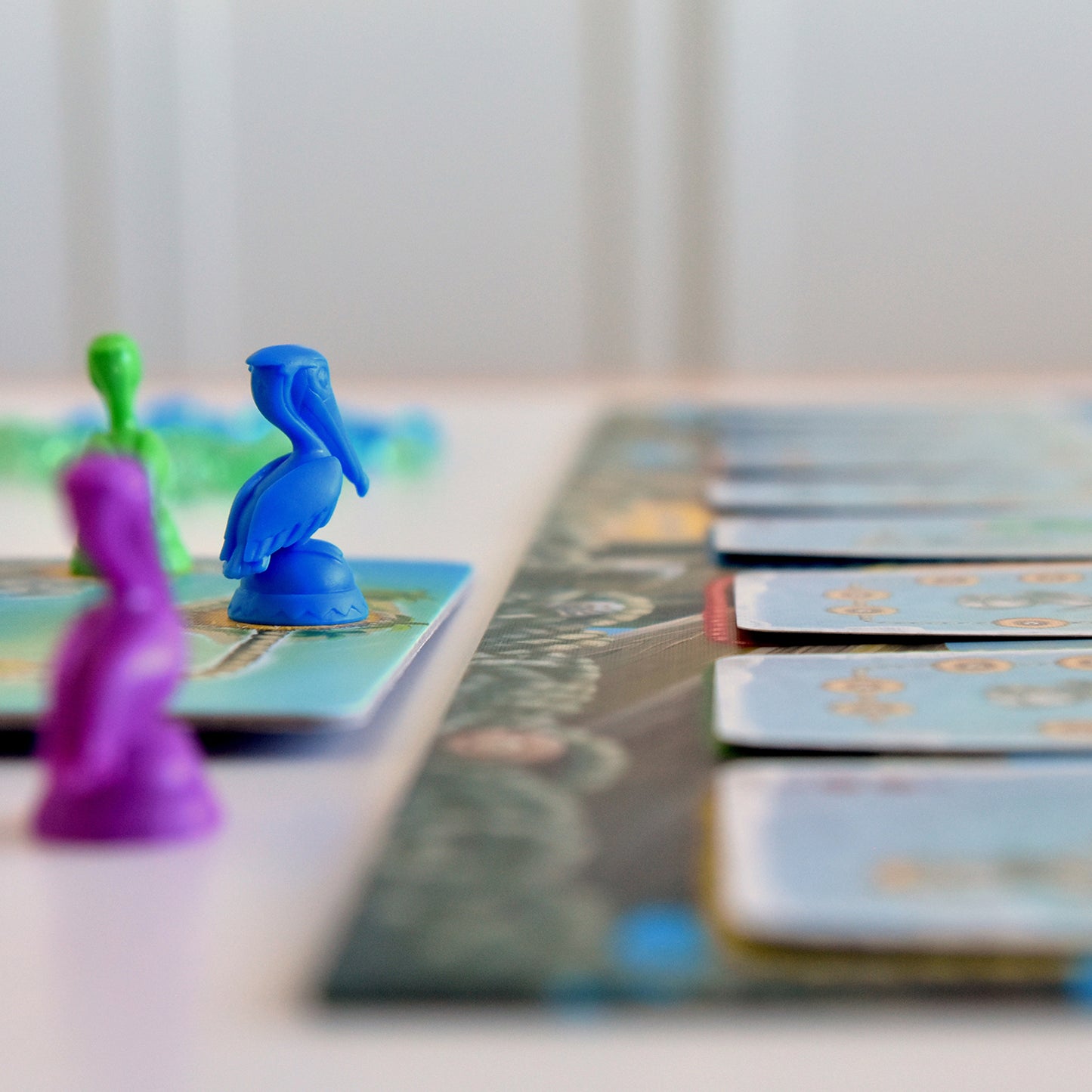
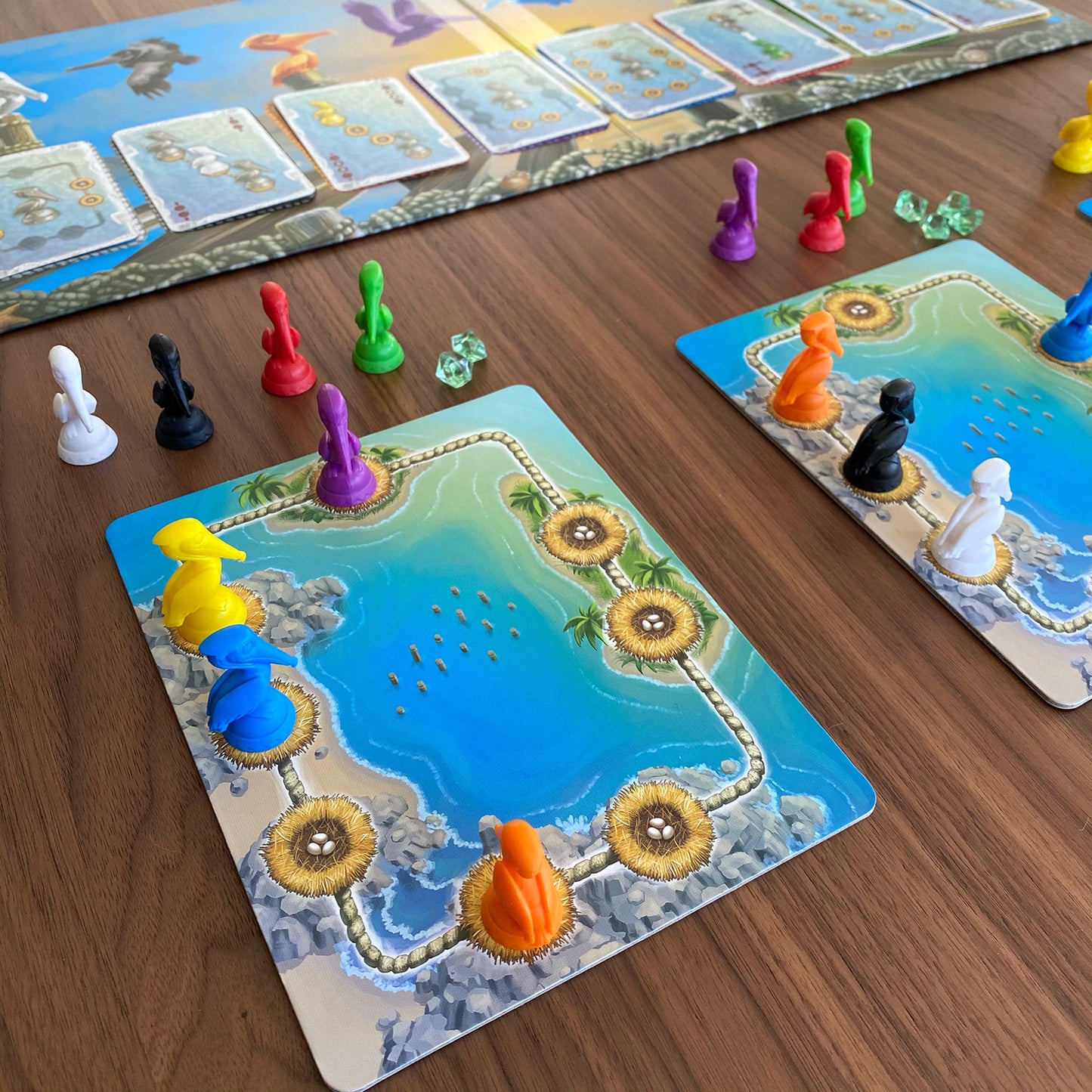
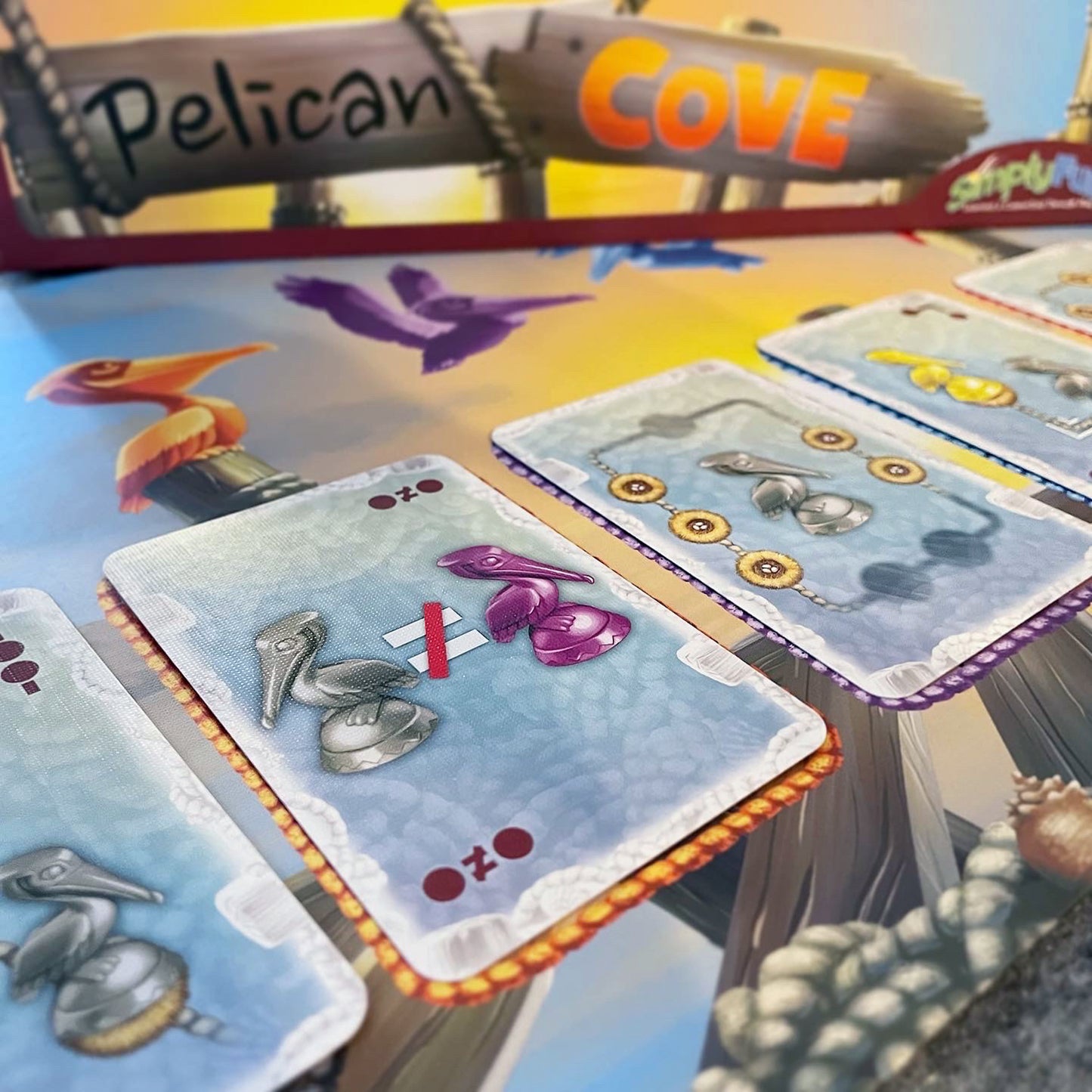
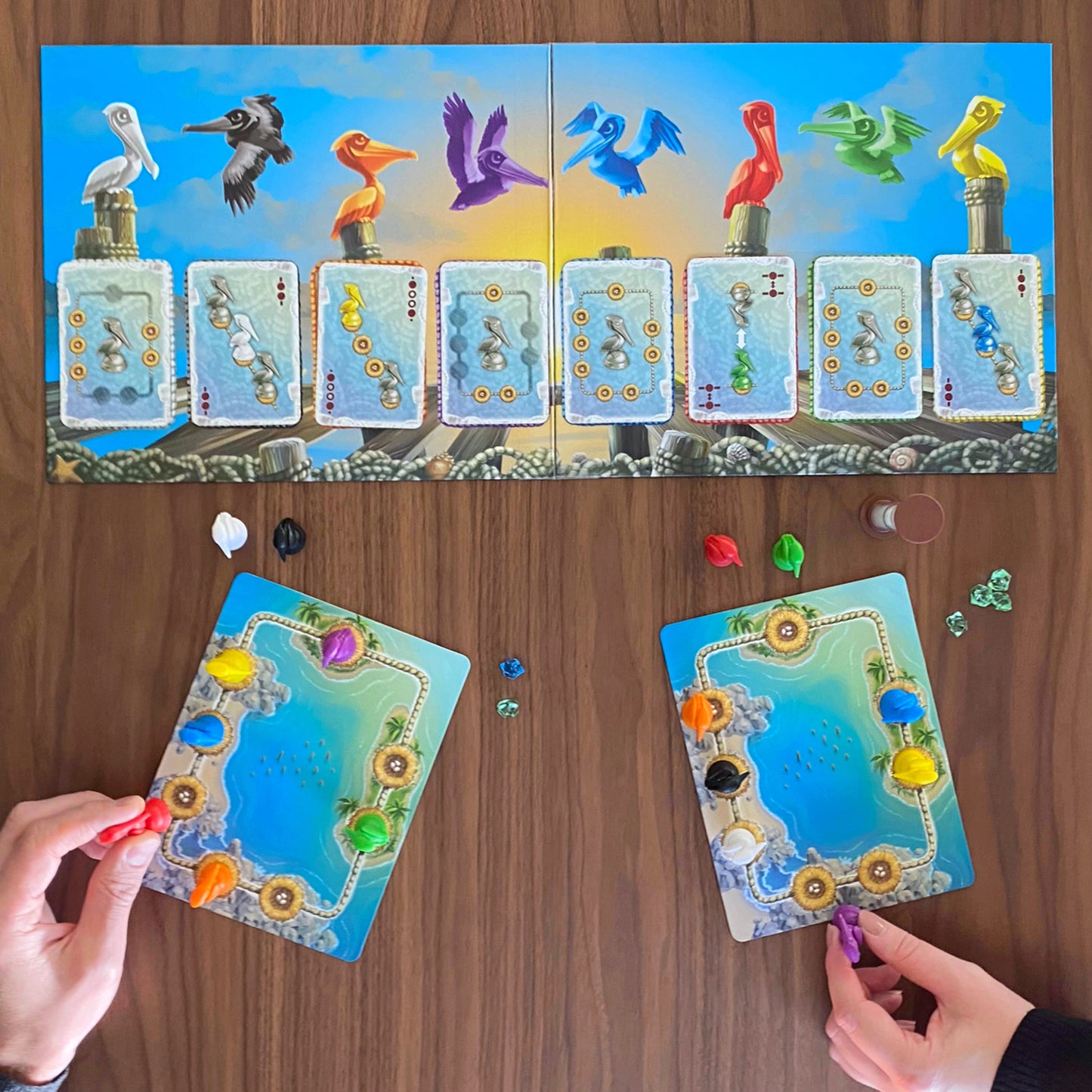


Collapsible content
How to Play
Educational Standards
Core Standard*: Math
Math:
- Operations and Algebraic Thinking
- Solve problems involving the four operations, and identify and explain patterns in arithmetic. Grade Level 3rd
- Generate and analyze patterns. Grade Level 4th
- Mathematical Practice
- Make sense of problems and persevere in solving them. Grade Levels 3rd, 4th, 5th
- Reason abstractly and quantitatively. Grade Levels 3rd, 4th, 5th
Skills
Explore
What Does Child Do To Use Skill In The Game?
Players need to spend time looking at the Request Cards in order to understand the directions each card represents. They also need to look closely at all 8 cards on the game board during each turn.
How Parents Can Assist Learning
When learning the game, children should be given time to play with the cards, arrange pelicans and generally explore all the features of the game play. This will allow the children to develop some mastery over the content so that they can be more successful in the actual game.
Learning Implications and Educator Support
When learning the game, children should be given time to play with the cards, arrange pelicans and generally explore all the features of the game play. This will allow the children to develop some mastery over the content so that they can be more successful in the actual game.
Determine
What Does Child Do To Use Skill In The Game?
Determining is one of the key skills developed in this game. Players need to combine information from the Request Cards in order to determine the optimal arrangement of pelicans.
How Parents Can Assist Learning
When learning the game, children should be given time to play with the cards, arrange pelicans and generally explore all the features of how the game is played. This will allow the children to develop some mastery over the content so that they can more quickly determine the Requests during the game. Also, when learning the game, play without a timer and say aloud the Requests. Verbalizing will help all of the players learn the Pelican Cove game features.
Learning Implications and Educator Support
When learning the game, children should be given time to play with the cards, arrange pelicans and generally explore all the features of how the game is played. This will allow the children to develop some mastery over the content so that they can more quickly determine the Requests during the game. Also, when learning the game, play without a timer and have the children say the Requests aloud. Verbalizing will help all of the players learn the Pelican Cove game features.
Compare
What Does Child Do To Use Skill In The Game?
Players need to compare the request on the Request Card with the placement of the pelican they put on their Nesting Board.
How Parents Can Assist Learning
No special adult support required. However, because this game is timed, younger players may be impulsive. They need to be reminded to go a little more slowly in order to ensure that the placement of pelicans does not violate directions on the card(s). When first beginning to play the game it may be a good idea to omit the timer.
Learning Implications and Educator Support
No special adult support required. However, because this game is timed, younger players may be impulsive. They need to be reminded to go a little more slowly in order to ensure that the placement of pelicans does not violate directions on the card(s). When first beginning to play the game it may be a good idea to omit the timer.
Remember
What Does Child Do To Use Skill In The Game?
Players need remember what the requests are for each Request Card.
How Parents Can Assist Learning
Children should practice numerous times prior to playing the first time in order to remember what the Request Cards mean. Additionally, parents can make additional copies of the Card Reference Guide for any child that wants one.
Learning Implications and Educator Support
Children should practice numerous times prior to playing the first time in order to remember what the Request Cards mean. Additionally, parents can make additional copies of the Card Reference Guide for any child that wants one.
Plan
What Does Child Do To Use Skill In The Game?
Players quickly plan, or use trial and error, to determine where to place their Pelicans based on the Request Cards
How Parents Can Assist Learning
Trial and error is a good strategy for learning Pelican Cove. Rather than trying to figure out mentally where all the Pelicans go, children can figure out the spatial relations by placing the White Pelican and then moving on to the Black Pelican and so on. They can adjust as needed based on the Requests for Orange, Purple and so on. As the child becomes more adept with spatial thinking and planning, they will be able to mentally consider where to place Pelicans and adjust those mental models as they consider more Requests.
Learning Implications and Educator Support
Trial and error is a good strategy for learning Pelican Cove. Rather than trying to figure out mentally where all the Pelicans go, children can figure out the spatial relations by placing the White Pelican and then moving on to the Black Pelican and so on. They can adjust as needed based on the Requests for Orange, Purple and so on. As the child becomes more adept with spatial thinking and planning, they will be able to mentally consider where to place Pelicans and adjust those mental models as they consider more Requests.
Experiment
What Does Child Do To Use Skill In The Game?
Like planning, trial and error experimentation is helpful strategic approach to learning and playing Pelican Cove.
How Parents Can Assist Learning
Trial and error is a good strategy for learning Pelican Cove. Rather than trying to figure out mentally where all the Pelicans go, children can figure out the spatial relations by placing the White Pelican and then moving on to the Black Pelican and so on. They can adjust as needed based on the Requests for Orange, Purple and so on. As the child becomes more adept with spatial thinking and planning, they will be able to mentally consider where to place Pelicans and adjust those mental models as thye consider more Requests.
Learning Implications and Educator Support
Trial and error is a good strategy for learning Pelican Cove. Rather than trying to figure out mentally where all the Pelicans go, children can figure out the spatial relations by placing the White Pelican and then moving on to the Black Pelican and so on. They can adjust as needed based on the Requests for Orange, Purple and so on. As the child becomes more adept with spatial thinking and planning, they will be able to mentally consider where to place Pelicans and adjust those mental models as they consider more Requests.
Practice
What Does Child Do To Use Skill In The Game?
Pelican Cove allows players to practice spatial reasoning.
How Parents Can Assist Learning
No special adult support required.
Learning Implications and Educator Support
No special adult support required.
Solve
What Does Child Do To Use Skill In The Game?
Players may try out different solutions by moving pelicans around their Nesting Board as they look at one Request Card after another. Also, players may try different strategic approaches, such as start with easiest requests first versus start with hardest requests first.
How Parents Can Assist Learning
This game involves use of visual spatial problem solving, directionality and if/then problem solving. Encourage children to move pelicans around their Nesting Board in order to see different arrangements and compare those to the Request Cards, looking for an optimal score. Also, suggest that they try different strategies until the find one or two that work best for them.
Learning Implications and Educator Support
This game involves use of visual spatial problem solving, directionality and if/then problem solving. Encourage children to move pelicans around their Nesting Board in order to see different arrangements and compare those to the Request Cards, looking for an optimal score. Also, suggest that they try different strategies until the find one or two that work best for them.
Review
What Does Child Do To Use Skill In The Game?
Players are required to review their Nesting Board in order to evaluate their moves and score.
How Parents Can Assist Learning
No special adult support required.
Learning Implications and Educator Support
Educators can use the review process to discuss what worked and did not. Ask children to explain why they chose to place Pelicans in specific nests in order to determine if they understood the Requests or are having difficulty with spatial reasoning.
Demonstrate
What Does Child Do To Use Skill In The Game?
While not required, a player may demonstrate their thinking if prompted by an adult.
How Parents Can Assist Learning
Ask children to walk through each of the cards and explain what they did and why. Parents can see if children misunderstood a Request, so they can interpret it correctly on the next turn.
Learning Implications and Educator Support
Ask children to walk through each of the cards and explain what they did and why. Educators can see if children misunderstood a request, so they can interpret it correctly on the next turn.
*Data compiled from CCSSI ELA Standards, WA Science Standards, and Washington Social Studies Standards
Special Needs
Cognitive
Suggestions for How to Modify Play Experience
For children with cognitive delays, omit the timer. This gives the child more time to think.
For children with cognitive delays, use Level I and II cards only. When children understand how to do Level I and Level II, add Level III.
Interpreting the gray pelicans on the cards as being the color of the pelican above may be difficult for children with cognitive delays. If extra pelicans are available, set the appropriate color pelican on the cards after they are dealt. This gives the child an extra visual cue as to what to do.
Communication
Suggestions for How to Modify Play Experience
For children with language comprehension concerns, use the pelicans to demonstrate the meaning of each card. Act out each card with the pelicans. This will make the verbal directions clearer. Walk through each card for each round, so the child understands all the requirements.
Using language to evaluate the placement of their pelicans provides practice for using prepositions appropriately.
Sensorimotor
Suggestions for How to Modify Play Experience
The pelicans are small, but stable, so children with only mild or moderate fine motor delays should be able to play the game. If needed, add a small cardboard circle to the bottom of the pelicans for increased stability. In addition, for children with fine motor delays other players can shuffle and deal the cards when it is this child's turn to deal.
Social Emotional/Behavioral
Suggestions for How to Modify Play Experience
For children with low frustration tolerance, attention concerns, or impulsivity, teams are recommended. Eliminate the timer, and use Levels I, II, and III as players acquire skill.
Vision
Suggestions for How to Modify Play Experience
This game is not recommended for children with low vision.
Hearing
Suggestions for How to Modify Play Experience
Another player can check the placement and verbalize the location of the pelicans for the child with hearing impairments, if speech is a concern.
Use sign language to walk through the justification after placing the pelicans.
*Data compiled from CCSSI ELA Standards, WA Science Standards, and Washington Social Studies Standards
Autism
Autism Special Considerations
Appears to ignore other's communication and/or has difficulty giving eye contact to a communication partner
Is This Game Appropriate for Child with Characteristic? Yes
Can Child with Characteristic Play Game w/o Modification? Yes
Strategies for Developing Compensatory Skills:
Look at the game instead of each other.
Rather than speak, sing communication between turns or when giving short directions. Music attracts the child's attention and interest.
Use unusual or exaggerated inflection to begin a communication about the game. This attracts the child's attention.
Has difficulty understanding complex verbal directions
Is This Game Appropriate for Child with Characteristic? No
Can Child with Characteristic Play Game w/o Modification? No
Strategies for Developing Compensatory Skills:
Children with special needs might be able to play level 1 or 2, but directions would need to be explained carefully and demonstrated.
Uses vocabulary inaccurately or demonstrates echolalia (repeating another's speech)
Is This Game Appropriate for Child with Characteristic? Yes
Can Child with Characteristic Play Game w/o Modification? No
Strategies for Developing Compensatory Skills:
Children do not need to talk during the game, but they must demonstrate that they have solved their nesting board correctly. Ability to use visual spatial terminology is preferred.
Respond to immediate echolalia (repeating what was just said) by rephrasing the child's response into a correct format, so the child can hear and repeat that phrase. For example, assume you are playing with a child named Andy and you say, "Your turn," and Andy repeats, "Your turn." You can say, "It's Andy's turn. You say, my turn." This allows the child to hear and repeat the correct response. Eventually, the child will pick up the pattern of response.
Delayed echolalia (repetition of previously heard comments) may have a hidden meaning or association. Look for connection in the phrase used to the current situation. For example, the child says, "After these messages we'll be right back!" Think what the repeated phrase is associated with for the child. Try to interpret what is meant and rephrase it for the child. For example, you might respond by saying, "It sounds like you want a break for a few minutes. Is that what you mean? You can tell me, 'I need a break.'"
Gets stuck repeating a verbal topic or physical actions and/or has difficulty attending to others' actions or topic.
Is This Game Appropriate for Child with Characteristic? Yes
Can Child with Characteristic Play Game w/o Modification? Yes
Strategies for Developing Compensatory Skills:
Encourage children to analyze other players boards to see if they are correct.
Reinforce attention and actions by commenting on what was done correctly. For example, "You got three pelicans right!"
Has difficulty producing speech/communication
Is This Game Appropriate for Child with Characteristic? Yes
Can Child with Characteristic Play Game w/o Modification? No
Strategies for Developing Compensatory Skills:
Use augmentative communication, such as picture cards. For example, a picture of person pointing to another person means "your turn."
Some children may be able to visually solve the problem and place their pelicans correctly, but not be able to make a verbal explanation. Another player can help check the child's board and make the explanation.
Provide at least 10 seconds wait time for the child to process or produce responses. It may take longer to formulate a thought or response for children with special needs.
Has difficulty sequencing multi-step actions and/or doing complex abstract tasks
Is This Game Appropriate for Child with Characteristic? No
Can Child with Characteristic Play Game w/o Modification? No
Strategies for Developing Compensatory Skills:
Pelican Cove requires abstract thinking, and is not recommended for children who have difficulty with spatial orientation or visual spatial problem solving.
Demonstrates difficulty initiating and maintaining social interactions
Is This Game Appropriate for Child with Characteristic? Yes
Can Child with Characteristic Play Game w/o Modification? Yes
Strategies for Developing Compensatory Skills:
Social interaction is not a part of the game, until the check for accuracy at the end of a round.
Acts out or demonstrates avoidance behaviors when frustrated, overwhelmed, or needs more sensory input.
Is This Game Appropriate for Child with Characteristic? Yes
Can Child with Characteristic Play Game w/o Modification? No
Strategies for Developing Compensatory Skills:
Reduce extraneous noise or allow the child to wear head phones or ear plugs if loud sounds cause anxiety.
A weighted vest worn during the game may provide additional pressure input and thus reduce fidgeting due to sensory needs. Pressure can be calming when used for no more than 20 minutes at a time.
Practice a phrase to ask for help and role play situations in the game where it is needed.
Provide techniques for self-calming, such as holding a special toy.
Allow time for movement. For example, a child who needs to move frequently can be given an opportunity to 'celebrate' their turn by running around the table or jumping up and down 10 times.
Has short attention span for non-preferred activities
Is This Game Appropriate for Child with Characteristic? No
Can Child with Characteristic Play Game w/o Modification? No
Strategies for Developing Compensatory Skills:
Pelican Cove is not recommended for children who have difficulty focusing attention on abstract visual spatial tasks.
Needs sameness or consistent routines and/or has difficulty with transitions from one activity to another
Is This Game Appropriate for Child with Characteristic? Yes
Can Child with Characteristic Play Game w/o Modification? Yes
Strategies for Developing Compensatory Skills:
Play games at the same time every day, so the child anticipates the game routine.
Change the location of the game, so the child may play in different rooms, at the table, or on the floor. This will build tolerance for variation. Prepare the child ahead time for the introduction of a new game. Talk about aspects that will be motivating for the child, and let them explore the parts of the game before setting out the whole game.
Provide a structure for placement of game pieces that can be the same each time the game is played. For example, have a specific location for where the board goes, the pieces, etc.Provide choices for how the child can be involved in set up or clean up. For example, you might ask, "Do you want to deal the cards or hand out the nesting boards?"
Involve the child verbally and with actions for the transition to the game table or at the end of game play. For example, you might say, "Let's look at the pictures on the game box and guess what it is about."
Use an object cue. Let the child hold an object from the game or activity you want to introduce prior to the transition. For example, if you were intending to play Pelican's Cove you would hand the child a pelican from the game and say, "Look here is a pelican. What game does it go with?"
Has difficulty understanding others' feelings, intentions, and the reasons for others' actions.
Is This Game Appropriate for Child with Characteristic? Yes
Can Child with Characteristic Play Game w/o Modification? Yes
Strategies for Developing Compensatory Skills:
Model and point out what others are feeling and comment on their facial expressions or words.
Ask child to explain their own feelings and intentions.
*Data compiled from CCSSI ELA Standards, WA Science Standards, and Washington Social Studies Standards
Extended Play
Extra Ways to Play the Game
Play the game in pairs.
Materials Needed
No extra materials needed.
Developmental Benefits
Playing in pairs allows children to discuss the meaning of the direction cards and explore options for where to place the pelican on the board. Working in pairs can help children be more successful as they can check each other's placement.
Extra Ways to Play the Game
As preparation prior to playing the actual game, do the following activity to learn what each card means and placement of pelicans. Set the game board on its side so it becomes a visual shield. One player gives directions (Player 1) and other players each have a nesting card. Player 1 describes where to place the different colored pelicans and the other players listen and try to follow the directions. Make sure that all players orient their nest card horizontally so that the side with one nest is on the playe'rs left. When all pelicans are placed, check who is correct. Give each correct player a jewel.
Materials Needed
No extra materials needed.
Developmental Benefits
This modification is good for beginners. It will familiarize them with the locations of the nests in relation to each other.
Extra Ways to Play the Game
Here is a fun "intermission" between games. Turn the board over to side two. Put one pelican on each card so that the pelicans are in reverse color order of color on the cards. Starting on the yellow rectangle, place the white pelican. On the green place the black pelican and so on, with orange, purple, blue, red, green and yellow on following rectangles. Use the timer and one die for each of two players. Players have one minute to get each pelican onto its matching rectangle. Players continuously roll their die moving their pelicans backward and forward with each roll until all are in place. Players may split the number on the die if needed to obtain a number needed to move a pelican. No more than 2 pelicans can be on a space at any one time.
Materials Needed
Two dice and a timer.
Developmental Benefits
The benefit of this game is that children practice counting, adding, and subtracting to get to the numbers they need. Using the timer increases the need for quick thinking.
*Data compiled from CCSSI ELA Standards, WA Science Standards, and Washington Social Studies Standards
Collapsible content
How to Play Video & Transcript
Today, we’ll learn how to keep a picky bunch of water birds happy when we learn how to play Simply Fun’s Pelican Cove, a game of Preferences where the Pelicans decide which nest is best!
Pelican Cove can be played with 1 to 5 players ages 8 and up.
Every Pelican Cove box comes with:
• one 2-sided game board
• five Nesting Boards
• forty Pelican pawns (in 8 colors)
• eighty Request cards
• forty Penalty stones
• one 45-second timer, and
• one rules booklet
Pelican Cove is a fast-paced game that helps build pre-algebra thinking and complex decision-making skills, all while meeting the requests of a bunch of demanding pelicans AND working against the timer!
To set up the game, place the large game board in the middle of the table. Each player should then take a nesting board and one of each of the 8 different colored pelican pawns.
Next, shuffle the 80 request cards and place them face down, along with the sand timer and the penalty stones, next to the game board.
Note that there are five levels of Request Cards, each increasing in difficulty, 1 being easiest, 5 being most difficult. When playing for the first time, players may want to use only Level 1 to Level 3 request cards to familiarize themselves with basic gameplay.
Refer to the rules booklet for specifics in the Request Card Reference Guide.
Pelican Cove is played in 6 rounds, and each round has 3 phases:
1. The Place Request Cards phase begins the game when the first player draws 8 request cards from the deck and puts them, face up, on the 8 spaces of the game board. These spaces correspond to the 8 colored pelican pawns held by each player. The cards indicate where each of the pelicans wants to nest.
2. In the Placement of the Pelicans phase, the starting player flips over the sand timer, and all players simultaneously place their pawns on the nests located on their own nesting boards before time runs out. Each player must try to accommodate each pelican’s request or the birds will not be happy – and the player will take a penalty!
3. In the Evaluation and Penalties phase, each request card is evaluated, from the left side of the game board to the right, to see which players were able to complete each pelican’s request. The starting player reads where each bird should be and the other players announce whether they were correct or not. If a request was met, it’s all good. If the request was NOT met – or a pelican was left off the nesting board – the player must take a green penalty stone. If a player holds 5 green stones, he may trade them for a blue 5-point stone. You do NOT want the blue stones!
Here is an example of play. If the request cards were placed like this, and the pawns were placed like this, then the evaluation would look like this:
1. The white pelican can be placed anywhere, so this request is fulfilled.
2. The black pelican requested to be by the green one. Request fulfilled.
3. The orange pelican wanted to be across the board from the white one. Looks good.
4. The purple pelican wanted the same nesting placement as the black one – beside the green pelican. All good.
5. The blue pelican wanted to share a corner with the red one. He didn’t. The player must take a green penalty stone.
6. The red pelican didn’t want to be beside OR across from the orange pelican, and since he was placed like this, he got his way. Note that sharing perpendicular sides of a corner is not the same as being BESIDE each other. Request fulfilled.
7. The green pelican wanted to share a corner with the black pelican. Since they’re sitting side-by-side, the request was not fulfilled and the player must take a penalty stone.
8. Finally, the yellow pelican asked for the OPPOSITE of what the purple pelican requested, which was, via the black pelican, to be placed beside the green one. Since the yellow pelican is NOT beside the green one (the opposite of the purple pelican’s request) he is happy. Request fulfilled.
More specific rules for requests, placement and evaluation can be found in the rules booklet.
A round is over after each evaluation phase is complete, and play continues with the next player drawing – and placing – 8 new request cards on the game board.
The game ends when a total of 6 rounds are completed. The player with the fewest Penalty stones wins!
There are several other ways to play Pelican Cove, including how to play it by yourself and using the flip side of the board when playing with younger and older kids together. Refer to the rules booklet for game variants.
Pelican Cove is a fun way to teach kids the complexities of assessing what to do within decision hierarchies. It scales in difficulty, accommodating players of different abilities. AND, because these pelicans are plastic, you don’t have to deal with the noise real pelicans make when they don’t get what they want… Mine! Mine! Mine!

